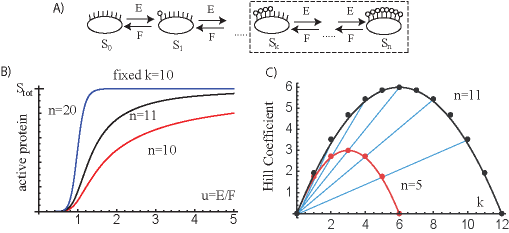Absolute Concentration Robustness

Chemical reaction networks lie at the heart of biological processes at the cell level such as signal transduction, development, gene expression and metabolism. These processes are often under strict regulation to prevent an unintended outcome given large amounts of noise. A possible mechanism to ensure a reliable concentration of a key protein from cell to cell is absolute concentration robustness. We assume two or more different forms of a protein, and only one of them is active. Through a particular type of chemical reaction structure one can ensure that the active protein concentration remains constant. This idea extends to the stochastic case, in which the protein output can be shown to have an approximately Poisson distribution after finite time.
For example, in the above picture you can see a simple example of a chemical reaction and its steady state behavior. The steady state of A is constant, regardless of the total amount of protein.
Ultrasensitivity in the Absence of Allostery

Cells are often faced with what one could describe as a decision to make: should it grow and divide in response to a given stimulus? Should it differentiate into a heart cell or a liver cell? Understanding the roots of cellular decision-making is a key problem in biology: for instance, a cell that divides too easily in response to a stimulus can - and often does - turn cancerous. In this project, we seek to understand some of the basic mechanisms that cells likely use to produce such all-or-none behaviors. We are pursuing an alternative to the so-called allosteric mechanism, which was first developed in work by Monod and others in 1965. While that elegant mechanism is rightly well known and widely cited, there may be many analogous biological systems where this property is not satisfied and which may have been overlooked. Recent work by my colleagues and I provides an example of decision systems which are similar to allosteric systems but do not require that property. We are applying this principle to several specific systems of importance in molecular biology such as gene regulation and cell communication. We are also studying the mathematical properties of these new systems and seeking to collaborate with experimental biologists to determine to what extent these theoretical mechanisms represent actual biological functions.
Additional Research Projects
Under construction...

